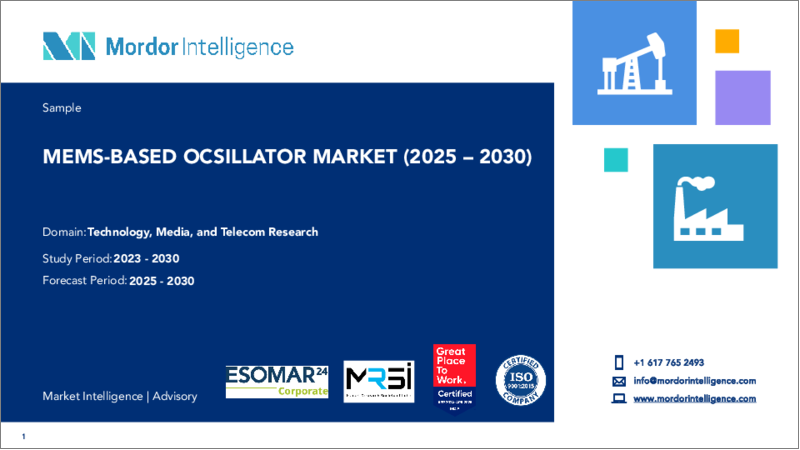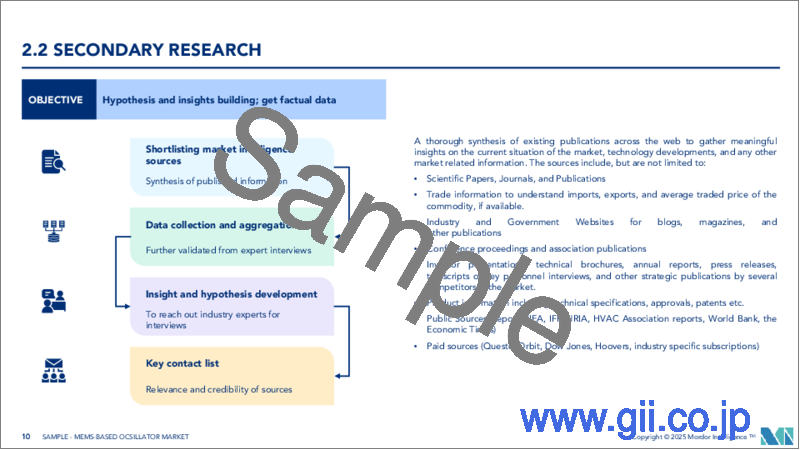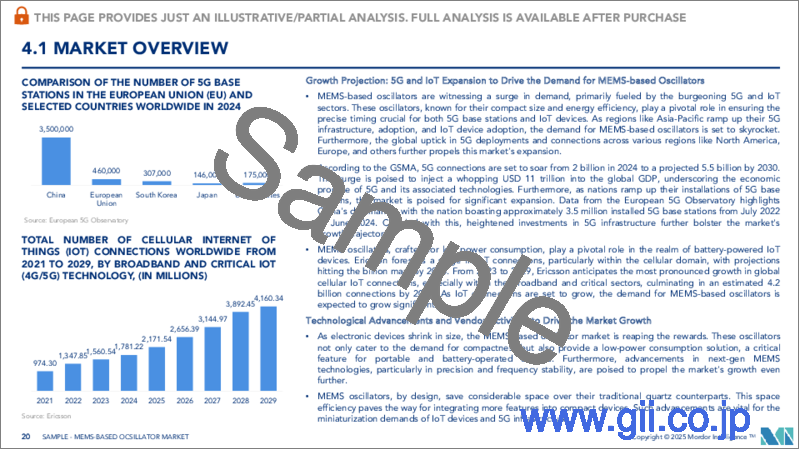|
|
市場調査レポート
商品コード
1685926
MEMSベース発振器:市場シェア分析、産業動向・統計、成長予測(2025年~2030年)MEMS-based Oscillator - Market Share Analysis, Industry Trends & Statistics, Growth Forecasts (2025 - 2030) |
||||||
カスタマイズ可能
適宜更新あり
|
|||||||
| MEMSベース発振器:市場シェア分析、産業動向・統計、成長予測(2025年~2030年) |
|
出版日: 2025年03月18日
発行: Mordor Intelligence
ページ情報: 英文 131 Pages
納期: 2~3営業日
|
全表示
- 概要
- 目次
MEMSベース発振器市場規模は、2025年に3,600億米ドルと推定され、予測期間(2025-2030年)のCAGRは28.76%で、2030年には1兆2,600億米ドルに達すると予測されます。

MEMS発振器市場は、世界中の最終用途産業からの製品需要の増加により加速しています。
主なハイライト
- MEMS発振器は、モーメントを測定できる極めて安定した基準周波数を作るのに役立つタイミング装置の一種です。情報交換の管理、タイミングの評価、無線周波数の記述、電子機器の発注のために、これらの比較周波数は頻繁に使用されます。
- MEMSとシリコンベースの技術はまた、広い周波数範囲で動作し、周波数ジャンプの影響を受けにくく、機械的衝撃、振動、温度変化に強いです。その結果、この技術は、堅牢で高性能、かつプログラマブルな小型タイミング・ソリューションの開発に役立っています。
- 例えば、マイクロチップ社のシリコンMEMSベース発振器DSC1001は、1MHz~150MHz、電源電圧1.8~3.3VDC、温度範囲-40℃~105℃など、幅広い電源電圧と温度に対応しています。このデバイスは、10ppmという低いジッターと安定性性能を提供します。
- MEMS発振器の開発には高い研究開発費がかかるため、市場に参入する企業の数は限られており、MEMS発振器の開発数は減少する可能性があります。同市場の既存企業は、次世代シリコン・タイミングシステム・ソリューションの設計・開発に多大な研究開発費を投じています。
- COVID-19の発生は周波数制御デバイスの生産に大きな影響を及ぼし、自動車、家電、航空宇宙産業全体で完成品の出荷に遅れが生じました。有名な半導体工場の閉鎖により、サプライチェーンは深刻な打撃を受けました。しかし、呼吸器診断やCOVID-19患者監視を研究するための他の研究ツールなど、マイクロ流体や圧力がCOVID-19に接続されているため、医療監視アプリケーション用のMEMSベース発振器デバイスは恩恵を受けています。
MEMSベース発振器の市場動向
コンシューマエレクトロニクス分野が大きな市場シェアを占める
- 発振器は、振動する水晶(圧電材料)の機械的共振を利用して特定の周波数の電気信号を発生させる電子回路です。MEMS発振器は、プログラマブルアーキテクチャに基づく完全なタイミングシステムです。MEMS発振器は、機能性の向上、性能の強化、電子デバイスの小型化により、さらに大きな需要を目の当たりにしています。発振器は、エネルギー変化に基づく2つのもの間の周期的な変動である発振の規則に基づいて動作します。コンピューター、スマートウォッチ、モバイルシステム、その他多くのデバイスがMEMS発振器を使用しています。
- ポータブル・エレクトロニクスやウェアラブル・エレクトロニクスの台頭により、すべての電子部品、特に発振器のエネルギー消費とフットプリントを削減する必要性が高まっています。微小電気機械システム(MEMS)技術に基づく発振器は、正確な周波数生成と低消費電力を兼ね備え、クロック回路でますます普及しています。
- MEMS発振器は、低消費電力、小型、高性能、物理的堅牢性という魅力的な組み合わせを提供し、特にポータブル・エレクトロニクスやウェアラブル・エレクトロニクスなど、数多くのアプリケーションに理想的です。さらに、携帯電話、コンピュータ、時計、ラジオ、および他の多くのデバイスは、タイミングパルスを開発し、イベントを同期させるために正確な周波数で出力を提供する電子発振器の成功に依存しています。
- さらに2022年5月、タイティエンは消費電流がわずか1.4μAの超低電流水晶発振器OZ-DとOY-Dを発売しました。低消費電力設計、小型、高精度が特徴で、ウェアラブルガジェットやモノのインターネット(IoT)機器に広く使用できます。
- MEMSタイミング技術の革新は、ウェアラブル・アプリケーションにおける物理的スペースと電力の節約に大きく貢献し、同時に信頼性も向上させます。このような場合、このセグメントは民生機器に分類されるため、コストが大きな課題となります。さらに、特に民生市場において5Gネットワーク展開の到来に伴い、民生用電子機器向けの小型で高周波対応、タイミングスロップの少ないMEMS発振器への需要が拡大すると予想されます。
アジア太平洋が最も急成長する市場になる見込み
- アジア太平洋は、中国、日本、インド、韓国といった国々の存在により、主要な地域市場になりつつあります。この地域を拠点とする組織の基盤には、フィットネス活動、スマートウォッチ、医療モニター/デバイスなどのウェアラブル技術に対する需要の高まりがあります。このことは、アジア太平洋地域におけるMEMSベース発振器市場の成長可能性を示しています。
- さらに、この地域では、消費のアップグレードが勢いを増し、ハイテクに精通した消費者がより便利でハイテク主導の生活を受け入れるためにそのようなガジェットにお金を払うことを厭わないため、インテリジェントなウェアラブルが流行しつつあります。
- 原材料が豊富に入手可能で、設立費用や人件費が安いことも、企業がこの地域で研究開発や生産拠点を立ち上げるのに役立っています。例えば、京都に本社を置く電子機器メーカーの京セラは、2021年1月に鹿児島県霧島市の国分キャンパスに新しい研究開発センターを建設すると発表しました。
- また、同市場で事業を展開する企業は、市場のニーズに対応し、顧客基盤を拡大するために、買収や統合、新製品の提供、提携、パートナーシップ、事業拡大など、さまざまな成長戦略を採用しています。
MEMSベース発振器産業の概要
MEMSベース発振器市場には、後方および前方統合が可能な大規模ベンダーが存在し、大きな収益創出能力を有しています。市場競争は激化しており、ベンダーは技術力と他企業に対する競争力を獲得するため、研究開発への投資を増やしています。ベンダーは技術と品質で競争しているが、価格では競争していないです。また、サードパーティの鋳造・組立能力をめぐる競合も激しいです。ほとんどのメーカーは、自社製品の製造と組立をこの能力の有無に依存しているからです。
2022年9月:SiTime Corporationは、同社の高度なMEMS技術に基づく独自の車載用発振器シリーズを発表しました。再設計された差動発振器は、耐久性が10倍向上し、過酷な走行条件や温度下でのADASの信頼性を保証します。最新の車載用発振器AEC-Q100 SiT9396/7のデビューにより、SiTimeのサービス対象市場(SAM)は5,000万米ドル拡大します。
2022年7月:Abracon LLC(アブラコン)はGenstar Capitalが買収したと発表しました。Genstarは、産業、金融サービス、ヘルスケア、ソフトウェア業界の対象セグメントへの投資に重点を置くプライベート・エクイティ・ファームです。
その他の特典
- エクセル形式の市場予測(ME)シート
- 3ヶ月間のアナリスト・サポート
目次
第1章 イントロダクション
- 調査の前提条件と市場定義
- 調査範囲
第2章 調査手法
第3章 エグゼクティブサマリー
第4章 市場洞察
- 市場概要
- 業界の魅力度-ポーターのファイブフォース分析
- 供給企業の交渉力
- 買い手の交渉力
- 新規参入業者の脅威
- 代替品の脅威
- 競争企業間の敵対関係の強さ
- 業界バリューチェーン分析
- COVID-19が市場に与える影響の評価
- MEMS発振器を採用する際の主な検討事項
第5章 市場力学
- 市場促進要因
- シリコンベースの製造技術とパッケージング技術の先進性
- 市場の課題
- 研究開発コスト高につながる複雑な設計
- 市場機会
- より優れたタイミング・デバイスの需要を生み出す5Gの出現
第6章 市場セグメンテーション
- タイプ別
- 温度補償発振器(TCXO)
- スペクトラム拡散発振器(SSXO)
- 電圧制御発振器(VCXO)
- デジタル制御発振器(DCXO)
- その他のタイプ
- エンドユーザー産業別
- 自動車
- 航空宇宙・防衛
- コンシューマー・エレクトロニクス
- ITおよび電気通信
- その他エンドユーザー産業
- 地域別
- 北米
- 欧州
- アジア太平洋
- 世界のその他の地域
第7章 競合情勢
- 企業プロファイル
- Maxim Integrated Products Inc.(Analog Devices Inc.)
- Microchip Technology Inc.
- HMI Frequency Technology
- Shenzhen Yangxing Technology Co. Ltd
- Abracon LLC
- TXC Corporation
- SiTime Corporation
- Daishinku Corporation
- Rakon Limited
第8章 投資分析
第9章 市場の将来
The MEMS-based Oscillator Market size is estimated at USD 0.36 trillion in 2025, and is expected to reach USD 1.26 trillion by 2030, at a CAGR of 28.76% during the forecast period (2025-2030).

The MEMS oscillator market is accelerated due to increased demand for products from end-use industries worldwide.
Key Highlights
- MEMS oscillators are a class of timing apparatus that help create extremely stable reference frequencies that can measure moments. In order to manage information exchange, assess the timing, describe radio frequencies, and place orders for electronic devices, these comparison frequencies are frequently used.
- MEMS and silicon-based technologies also operate over a broad frequency range, are less sensitive to frequency jumps, and are highly resistant to mechanical shock, vibration, and temperature changes. As a result, this technology has been helpful for developing small-sized timing solutions that are also robust, high-performing, and programmable.
- For instance, the silicon MEMS-based oscillator DSC1001 from Microchip offers a broad range of supply voltages and temperatures, including 1MHz to 150MHz with supply voltages between 1.8 and 3.3 VDC and temperature ranges up to -40C to 105C. The device offers jitter and stability performance as low as 10ppm.
- The high R&D costs involved in the development of MEMS oscillator is poised to limit the number of companies operating in the market, which may lead to fewer developments of MEMS oscillators. The established players in the market put significant R&D efforts into designing and developing next-generation silicon timing systems solutions.
- The COVID-19 outbreak had a significant impact on the production of frequency control devices, causing delays in the shipping of finished goods across the automotive, consumer electronics, and aerospace industries. Due to the closure of well-known semiconductor factories, the supply chain was severely harmed. However, as microfluidics and pressure are connected to COVID-19, including respiratory diagnostics and other research tools to study COVID-19 patient monitoring, MEMS-based oscillator devices for medical monitoring applications have benefited.
MEMS-Based Oscillator Market Trends
The Consumer Electronics Segment Holds Significant Market Share
- Oscillators are electronic circuits that develop an electrical signal of a particular frequency by utilizing the vibrating crystal's (piezoelectric material) mechanical resonance. MEMS oscillators are complete timing systems based on a programmable architecture. It further witnesses significant demand aided by improved functionality, enhanced performance, and electronic device miniaturization. An oscillator works on the regulations of oscillation, a periodic fluctuation between two things based on energy changes. Computers, smartwatches, mobile systems, and many other devices use MEMS oscillators.
- The rise in portable and wearable electronics drives the need to reduce the energy consumption and footprint of all electronic components, especially oscillators. Oscillators based on Micro-Electro-Mechanical Systems (MEMS) technology combine accurate frequency generation with low power consumption and are becoming increasingly popular in clock circuits.
- MEMS oscillators offer an appealing combination of low power consumption, small size, high performance, and physical robustness, making them ideal for numerous applications, specifically in portable and wearable electronics. Further, cell phones, computers, watches, radios, and many other devices depend on their success on an electronic oscillator that delivers the output with a precise frequency to develop timing pulses and synchronize events.
- Moreover, in May 2022, TAITIEN launched ultra-low current crystal oscillators, OZ-D and OY-D, with current consumption of only 1.4μA, featuring a low power consumption design, small size, and high precision, that can be widely used in wearable gadgets and the Internet of Things (IoT) devices.
- Innovations across MEMS timing technology significantly contribute to physical space and power savings in wearable applications while improving reliability. Cost in such cases presents significant challenges as the segment falls into the consumer category. Further, with the advent of 5G network rollouts, particularly in consumer markets, the demand for compacter, higher frequency enabled, less timing slop-based MEMS oscillators for consumer electronics is expected to grow.
Asia-Pacific is Expected to be the Fastest Growing Market
- The Asia-Pacific is becoming a primary regional market, owing to the presence of countries such as China, Japan, India, and South Korea. The foundation of organizations based out of the region includes the rising demand for wearable technology such as fitness activities, smart watches, medical monitors/devices, etc. This factor indicates the considerable growth potential for the MEMS-based Oscillator Market in the Asia-Pacific region.
- In addition, intelligent wearables in the region are becoming fashionable as consumption upgrade is gaining momentum and tech-savvy consumers are willing to pay for such gadgets to embrace a more convenient and tech-driven life.
- The abundant availability of raw materials and the low establishment and labor costs have also helped companies launch their R&D and production centers in the region. For instance, Kyocera, a Kyoto, Japan-based electronics manufacturer, announced the construction of a new research and development center in January 2021 at its Kokubu campus in Kirishima City, Kagoshima, Japan.
- Players operating in the market have also adopted various growth strategies, such as acquisitions and integrations, new product offerings, collaborations, partnerships, and business expansions to accommodate the market's needs and expand their customer base.
MEMS-Based Oscillator Industry Overview
The MEMS-based oscillator market has large-scale vendors capable of backward and forward integration and significant revenue generation capabilities. The market studied is highly consolidated, and vendors increasingly spend on R&D to gain technological capabilities and a competitive edge over other enterprises. The vendors are competing on technology and quality but not on price. Also, there is significant competition for third-party foundry and assembly capacity as most manufacturers depend on this capacity's availability to manufacture and assemble their products.
In September 2022: SiTime Corporation unveiled a unique automotive oscillator series based on the company's sophisticated MEMS technology. The redesigned differential oscillators are ten times more durable and assure ADAS reliability in harsh driving conditions and temperatures. The debut of the newest automotive oscillator, AEC-Q100 SiT9396/7, extends the SiTime serviced available market (SAM) by USD 50 million.
In July 2022: Abracon LLC (Abracon) announced that Genstar Capital had acquired it. Genstar is a private equity firm focused on investments in targeted segments of the industrials, financial services, healthcare, and software industries.
Additional Benefits:
- The market estimate (ME) sheet in Excel format
- 3 months of analyst support
TABLE OF CONTENTS
1 INTRODUCTION
- 1.1 Study Assumptions and Market Definition
- 1.2 Scope of the Study
2 RESEARCH METHODOLOGY
3 EXECUTIVE SUMMARY
4 MARKET INSIGHTS
- 4.1 Market Overview
- 4.2 Industry Attractiveness - Porter's Five Forces Analysis
- 4.2.1 Bargaining Power of Suppliers
- 4.2.2 Bargaining Power of Buyers
- 4.2.3 Threat of New Entrants
- 4.2.4 Threat of Substitute Products
- 4.2.5 Intensity of Competitive Rivalry
- 4.3 Industry Value Chain Analysis
- 4.4 Assessment of the Impact of COVID-19 on the Market
- 4.5 Key Considerations for Adopting MEMS Oscillators
5 MARKET DYANAMICS
- 5.1 Market Drivers
- 5.1.1 Advancement in Silicon-based Manufacturing and Packaging Techniques
- 5.2 Market Challenges
- 5.2.1 Complex Designs Leading to High R&D Costs
- 5.3 Market Opportunities
- 5.3.1 Emergence of 5G creating Demand for Better Timing Devices
6 MARKET SEGMENTATION
- 6.1 By Type
- 6.1.1 Temperature Compensated Oscillator (TCXO)
- 6.1.2 Spread Spectrum Oscillator (SSXO)
- 6.1.3 Voltage Control Oscillator (VCXO)
- 6.1.4 Digitally Controlled Oscillator (DCXO)
- 6.1.5 Other Types
- 6.2 By End-user Industry
- 6.2.1 Automotive
- 6.2.2 Aerospace and Defense
- 6.2.3 Consumer Electronics
- 6.2.4 IT and Telecom
- 6.2.5 Other End-user Industries
- 6.3 By Geography
- 6.3.1 North America
- 6.3.2 Europe
- 6.3.3 Asia-Pacific
- 6.3.4 Rest of the World
7 COMPETITIVE LANDSCAPE
- 7.1 Company Profiles
- 7.1.1 Maxim Integrated Products Inc. (Analog Devices Inc.)
- 7.1.2 Microchip Technology Inc.
- 7.1.3 HMI Frequency Technology
- 7.1.4 Shenzhen Yangxing Technology Co. Ltd
- 7.1.5 Abracon LLC
- 7.1.6 TXC Corporation
- 7.1.7 SiTime Corporation
- 7.1.8 Daishinku Corporation
- 7.1.9 Rakon Limited






